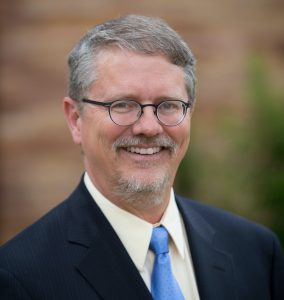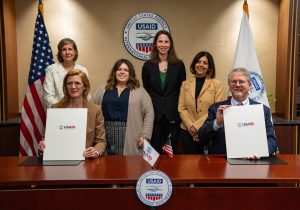Research into the international development sector and its effectiveness by the H & S Davidson Trust points to a flawed system badly in need of reform. In this series of interviews, we talk to figures in the sector in order to get their views on how we can co-create the narrative of the system we want and how we obtain it. In the latest instalment of our reforming international development series, Peter Laugharn, the President and CEO of the Conrad N. Hilton Foundation takes us down the road to changing international development for the long term
Charles Keidan: The world is facing many grave challenges. Out of those, what do you see as the most urgent problems that philanthropy must confront?
 Peter Laugharn: I would approach this question by talking about what I think is a promising way to go. That is bringing more people into solving problems, bringing resources closer to those who are experiencing the problems, and recognising the development of talent and capacity in areas that are facing great challenges and resourcing that talent and capacity.
Peter Laugharn: I would approach this question by talking about what I think is a promising way to go. That is bringing more people into solving problems, bringing resources closer to those who are experiencing the problems, and recognising the development of talent and capacity in areas that are facing great challenges and resourcing that talent and capacity.
Does that apply across a range of problems or are you thinking about specific ones?
I think it is part of the solution to most of the problems that we have. If you look at climate, at the humanitarian system and the crisis of migration, in all of those, the capacity for local solutions and local contributions is great, under-recognised, and there are simple things that are stopping us from funding better.
Could you describe some examples of how you’ve tried to fund better and differently in your work at the Hilton Foundation?
The Hilton Foundation is a kind of case study. Conrad Hilton said in his will, ‘As the funds you will expend have come from many places in the world, so let there be no territorial restrictions on your benefactions.’ We’ve done that. For more than 20 years, we did it through US nonprofits – Care, Save the Children, World Vision, Catholic Relief Services. I worked with Save the Children for 11 years and have a very high regard for the quality of their work but what we essentially did was to put 85 or 90 per cent of our international funding through these American non-profits.
When the 2016 world humanitarian summit set a 25 per cent goal for funding to local organisations, we pricked up our ears. The 2020 racial reckoning, sparked by the murder of George Floyd, prompted us to ask ourselves: what is equity and inclusion in our international grantmaking? We concluded that we should try to make that 25 per cent threshold. When USAID made a similar commitment a few months later, we said we’re in and we want to not only do it ourselves, but to help others in philanthropy and bilateral donors do it as well.

Kejia, Literary and Adult Basic Education (LABE) teacher, instructs young children at a Home Learning Center in her refugee settlement in Gulu, Uganda.
We went through an organisational transformation: how do we source grantees? What due diligence do we do? How easy do we make it for grantees to identify us? What’s our risk appetite? Are we meeting our tax authority compliance and still being able to get funds out there? Over the last four years, we’ve increased our international grantmaking to locally led organisations from approximately 15 per cent in 2019 to about 35 per cent in 2024. We’re also working both US and European philanthropy and bilaterals in this regard, particularly USAID. Almost all of the OECD funders that have large overseas development assistance budgets have signed a donor statement about locally-led development. We have 27 foundations on the foundation side alone. If they make the 25 per cent goal, that’s a billion dollars and on the bilateral side, it’s much more. It doesn’t mean that all money should go local, but it means a diversified portfolio, it means recognising the talent that is out there.
How much money do you ultimately think should go local or will that depend on the foundation?
For most programmes, I think that a 25 per cent threshold is not unreasonable. For some, it will be quite a bit higher. In our refugee programme, for example, in 2023, 60 per cent of our grantmaking within that initiative were awarded to locally led organisations making us the largest funder of refugee-led organisations in the world.
When you say local, what does that mean exactly?
Usually, it’s an organisation that is established and governed in the country in which it operates. It may be one that works in several countries on a continent, but we would still look at that as local.
In terms of local, people often think about community-based organisations, but it’s also local government. We have started making grants to municipalities who are often the greatest service providers to refugees. That’s a different version of local that you need to learn. There are also local think-tanks and very developed local NGOs, so we need to think of local as a broad and complex environment that may vary from country to country.
You’re shifting a substantial funding portfolio in a different direction. What are the challenges?
There are a number. One is that a lot of the bias toward NGOs from one’s own country is familiarity and trust. You have to separate out the legitimate basis for continuing from what is habit or fear of the unknown. We had to reassure folks that you can find local organisations with capacity. Another is that the non-profits working internationally are huge, they have a lot of capacity and a lot of experience, so sometimes they out-compete local organisations. You have to put effort into identifying local organisations that have the same or comparable skills. In terms of regulation, people in the US often think that the level of foundation regulation by the Internal Revenue Service is more difficult to satisfy than it actually is. Basically, you have to demonstrate that a local non-profit in Mozambique or in Colombia is the equivalent of a US non-profit, 501c3 public charity. We partner with NGO Source, an organisation that completes the data collection and analysis on NGOs, and they issue the certificate that we can then rely on to make our grants to organisations outside of the United States as if they were tax-exempt NGOs within the United States. It also helps the organisations themselves fundraise, because it’s a mark of their capacity.
You mentioned that much of the agenda to reform international development is about shifting funding practices in order to shift power. Research from the H&S Davidson Trust has identified four pathways to better funding practice: changing the role of INGOs from being donor-led to being more responsive to local circumstances, increased collaboration and partnerships, a more equal voice for local communities in decision-making, and increased unrestricted and longer-term funding. If we start with the changing role of INGOs, do you think this is actually an opportunity for them to engage in new ways with foundations like yours to demonstrate their ability to be local so that they’re part of a new course for international development?
I was an international NGO regional director in Africa in the 90s, and we saw that there was a lot of talent coming up through many local non-profit organisations, and we decided we should talk about what our comparative advantage was. At that time, this INGO was doing community organising in rural villages, and that makes no sense. Local organisations should be doing that. But there are centres of expertise in international NGOs that are advocating for and helping with fundraising for local NGOs, and they could also provide technical expertise, help with evaluation and so on, so our vision of expanding opportunity for local organisations does not exclude INGOs. A 25 per cent or even a 50 per cent local share leaves a lot on the table. It’s definitely time for INGOs to rethink their role. Often, this plays out between CEOs and boards because, in my experience, the CEOs understand this well and are really trying to think through a pathway forward, while the boards are often thinking about market share, so some of the work ought to be with the governance structures of international non-profits.
Do you think some of them are doing a better job than others?
I don’t know of a single American NGO working internationally that is not thinking about this. Some have opened themselves up more, but the issue is on the table from people who are in the field. As a funder of US international NGOs, we are in regular dialogue, and where they are interested in experimenting to extend this, that’s interesting for us to fund.
You mentioned the work you’re doing to assist other funders to reach the 25 per cent threshold for more locally-led development, and you’ve been very active personally in championing localisation. Could you say a bit more about how your work in this area?
One key example is the signing of the donor statement by basically the majority of the large American foundations working internationally including Packard, Hewlett and Rockefeller.

From left: Assistant to the Administrator of the Bureau for Planning, Learning and Resource Management (PLR) Michele Sumilas, USAID Administrator Samantha Power, Foreign Service Officer at USAID Lauren Bell, Senior Advisor for Localization at USAID Sarah Rose, Senior Director of Strategic Partnerships at the Conrad N. Hilton Foundation Shaheen Kassim-Lakha, and Hilton Foundation President and CEO Peter Laugharn in Washington, D.C. on Feb. 27, 2024.
There’s also a symbiosis between foundations and bilateral donor organisations. Bilaterals are often very oriented toward national policy, toward governments, while foundations tend to have better linkages with civil society, with the grassroots. If they can work together, they can establish a value chain that helps organisations funded by foundations get to the point where they can be funded bilaterally, or at least where there can be longer-term and more plentiful funding streams. The Hilton Foundation has signed an MOU with USAID partly to think about that issue, partly because, although they’re 100 times larger than we are in their budget, a lot of the internal decisions that need to be made to go more local are very similar in terms of sourcing, due diligence, and accountability. We felt there would be a really useful exchange of information, and encouragement that the world’s largest bilateral donor is on a promising track, and we want to help them do that.
Are bilaterals or development agencies now seeing foundations as a source of expertise and partnership in an endeavour to shift power? Is that where’s that conversation going?
I think there is an increased willingness from foundations to play that role and an increased level of experience to do that, and an increased openness from bilaterals to listen. At the same time that we passed that 25 per cent threshold, USAID has gone from six to nine per cent, which is great progress but still far short of their 25 per cent goal. So I think we are a bit of a proof point that this can be done. I would say too, we see this not just on our international funding. Our domestic funding to tackle homelessness in Los Angeles is of similar dimensions and similar internal dynamics to USAID. The County of Los Angeles has close to a $50 billion dollar budget, so if you learn how to help be more efficient and preserve more liquidity in the system and be a better funder, you can help the other as well.
What about the endeavour of giving a more equal voice for local communities in decision making. How far are we from that?
I’d say we’re on a path, but none of us has done this in a perfect or even a very good way. We tend to look at locally-led development at two levels; 1.0 and 2.0. The 1.0 is that we should give a larger proportion of our funding locally and that’s something we can do on our own. The 2.0 is sharing the strategy with those who are meant to benefit from our funding and that’s harder even for an organisation that wants to. You have to do a lot of participatory work. We are a strategic grant-maker, so we have a goal in mind, we always expect that those we grant to will have a goal of their own. The magic is finding those whose goals are in alignment with yours. But the more you open up, the longer the process becomes. So I think we were on a road for that.
Where are you between the 1.0 and the 2.0 at the Hilton Foundation?
We have established ourselves in a stable level for the 1.0. The 2.0, we’re still learning. We’re about to go into a strategy process and we should do that strategy differently from the last one. How much you bring in versus how much you set goals together is how you measure that. There are other foundations that are doing well. Even USAID, at least in its communication and its policies, is showing remarkable openness, and in practice they have really sought out the opinions of civil society platforms.
Could you mention a couple of foundations that you think are doing this well?
I think the Ford Foundation have always done this well. They have a bias toward equity and toward the grassroots, so being local is baked into what they do. The Packard Foundation is doing very interesting things in its climate funding and shows a very robust commitment. I think foundations in general are a lot less prone to say ‘we make the decisions and we’ll let you know’.
What about the question of unrestricted and longer-term funding, another important ingredient mentioned in the reforming international development research. How are you approaching that?
The Hilton Foundation is a strategic grantmaker so all our grantmaking is toward a defined end. Usually the issues we deal with are so complex that they’re not efficiently approached by ‘do-whatever-your-organisation-wants-to-type’ set-ups. I share the spirit of what you’re saying in terms of flexibility and solid support for the operating needs of a grantee and, as you go more local, often you find greater developmental needs, because they’re organisations that haven’t had the funding to build up their infrastructure.
The point about long-term funding is definitely important. Most of our grants are 2-3 years, and it can be longer if necessary. But we are trying to help assemble a real alliance of grantees whose work complements one another. In my experience, that’s helped by having solid commitments and objectives. I’ve spent half my career raising funds, and frankly, I would not have expected anyone to set the default as: ‘Peter, write us a proposal that says fund us to do whatever we want’. I would not have expected the bulk of my resources to come from general operating support.
That point is clear – there has to be that alignment with you’re looking for. We’ve talked about your 1.0 and 2.0 in the journey towards giving local communities more control over decision making. Could you see on the horizon a 3.0 in which, actually, not just control of strategy but control of governance is shifted to local organisations?
I think there is the talent and capacity out there to make that a possibility. We’ve experimented with something that’s interesting, which is making the local partner the principal, and then they sub-grant to international NGOs, which turns the usual relationship on its head. Some of those things are just logical evolutions. When you look closely at an environment and you say, what would be the best way to help change to happen? My expectation is that we will have more and more capacity locally as we go along and we should adapt to that.
Charles Keidan, executive editor at Alliance magazine






Comments (0)